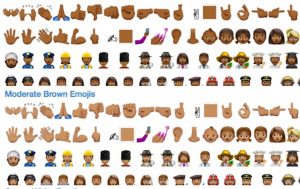What is your emoji-name?
by Neil Andersen.
Emojis are ideograms and smileys used in electronic messages and Web pages. (Wikipedia) Their uses are growing rapidly, especially in texting, to graphically represent ideas and emotions.
There are hundreds of emojis, with more being added.
What might students learn from researching and developing their own and others’ emoji-names? How and when might they use their emoji-names?
This lesson invites students to reflect on their personal values and how they want to represent themselves to others. It should also be fun.
It might start with a small-group discussion where students create a short description of what foods, activities and values they think are important. They might then research and assess which combination of emojis best communicate those ideas.
There are many issues that will naturally arise from this activity, principally involving representation. Even though this appears to be an opportunity for students to choose their own representations, they might discover and discuss limitations on the choices they have to make.
One fact that they will discover is that there are multiple sets of skin colour to choose from. Questions that might help them understand how choice of skin colour connects to issues of representation include:
Why is skin colour significant?
Why might the emoji-makers provide multiple sets?
Is there a skin colour that matches yours—or is your skin colour NOT represented? Is anyone else’s skin colour omitted?
How might people react if there were only ONE colour to choose from?
If you were to choose an emoji from one of these sets, would you choose one that closely matches your skin colour or a different skin colour? Why?





Another emoji set defines activities. Questions that might help students understand how choice of activities connects to issues of representation include:
Does the order of the images suggest a hierarchy, where the balls or sports that appear first are the more important, or is the order completely random? I.e., might a person seeing this order get the message that sports are more important than music, drama or gambling?
What activities are missing? How might an emoji represent one of those missing activities?
Many of the emojis represent male and female versions of the activities.
How might a transgender person feel about having to choose an activity?
What emoji might be designed to represent a transgender person in an activity?

Another emoji set represents foods and dishes. Questions that might help students understand how food choices connect to issues of representation include:
How might this chart suggest that fresh foods are more important than processed foods?
How might it suggest that some processed foods are more important or popular than others?
Which of your favourite foods are included or omitted?
What emoji could be created to represent one of your favourite—but missing—foods?
What if someone’s favourite food is a snack food? …canned food? …dried food? …frozen food?
Is there an emoji that shows a food you don’t know?
How might you find out what food it is representing?

In building their emoji-name, students will have to agree on some naming protocols, including:
Should there be a minimum and maximum number of emojis in an emoji-name?
What aspects of the person’s emoji-name should appear first, second, third, etc? E.g., should the emoji-name begin with a part of the person’s body, then present a favorite activity, then a food?
As students research, reflect and design, discussing their choices with others in a small group will help them understand and use issues of representation.
Once a student has designed her/his personal emoji-name, she/he might design one for someone or something else, e.g., a best friend, family member, her/his surname, school, city, etc. She/he might present the emoji-name with an explanation of how it represents the person or thing and the many choices she/he had to make.
Students might print their emoji names onto stickers and wear them as name-badges or place them on personal possessions, e.g., backpacks. They might use them as signatures in emails.
Copy-and-pastable emojis can be found here. An online emoji keyboard is available here, and extensions can be added to Chrome and Firefox that allow users to insert emojis into documents.
Have fun while learning about issues of representation!
😐🔎🙏🏼⌨️🏊🏼♂️👨🏼🍳🎶🍫
This is my own emoji-name design. Take time to read it and decide what I am trying to tell you about myself, then scroll down to see how well my intended representation was communicated.
⬇️
⬇️
⬇️
⬇️
⬇️
⬇️
⬇️
⬇️
⬇️
😐🔎🙏🏼⌨️🏊🏼♂️👨🏼🍳🎶🍫
There are many emojis that represent parts of me, but I decided that 8 was enough. I chose the 😐 because I am usually quiet and don’t speak more often than I have to. The 🔎 says that I look at everything carefully. The 🙏🏼 means that I think peace is important. The ⌨️🏊🏾♂️👨🏼🍳🎶🍫 mean that I like to write, swim, cook and listen to music. The 🍫 says that I love chocolate. The 🙏🏼🏊🏼♂️👨🏼🍳 emojis are selected from the light-skinned emoji set, representing me as a light-skinned person.
I like to reflect on the things I learn, but I couldn’t find an emoji to represent that part of me. I also love to go for dim-sum, but could not find a dim-sum emoji. I will have to design them.
(These lesson ideas are adaptable to both elementary and secondary school classrooms – ed.)




This is a terrific lesson.
How might teachers use it in a cross-curricular programme? Ancient Egyptians and other ancient peoples communicated visually through hieroglyphics. Middle school students can research these and compare/contrast their use to today’s use of emojis. Designing new emojis, even at a primary level, will also stimulate creative skills..